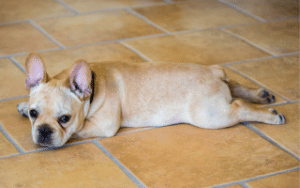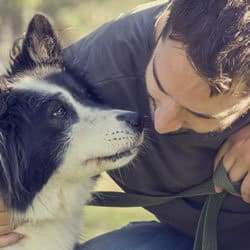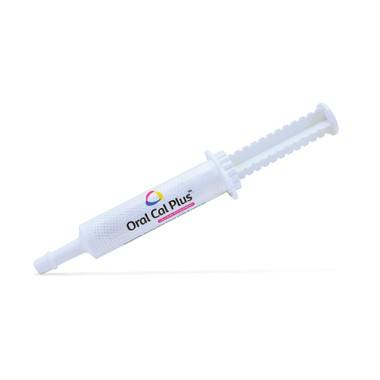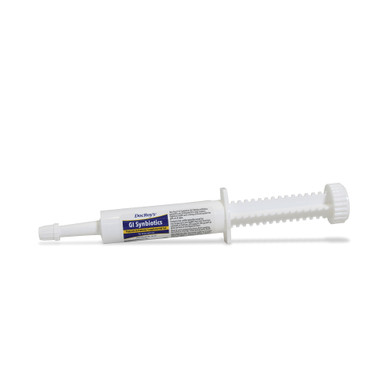Why do dogs sploot?
Estimated 0 min read

Dog in sploot position.
Ever find yourself giggling as you watch your canine companion stretch out into that adorable “sploot” position? You’re not alone.
This quirky behavior has captured the hearts of dog lovers everywhere. But have you ever wondered why dogs sploot in the first place, and what’s going on in their bodies when they do?
In this blog, we’ll take you on a journey through the fascinating world of canine biology and chemistry, as we delve into the science behind splooting. And, for those who want to train their dog to sploot—or stop splooting—we’ve got you covered! We’ll provide step-by-step guidance on how to encourage or discourage splooting.
So, are you ready to em-bark on this pawsome adventure? Join us as we dive into the captivating world of canine splooting!
Facts about dog splooting:
- Splooting helps dogs stretch muscles, regulate body temperature, and communicate social signals, such as playfulness or submission
- Joint health, breed predisposition, and environmental factors influence splooting frequency and potential risks
- Training to encourage or discourage splooting involves positive reinforcement, redirection, and providing comfortable resting surfaces.
Why do dogs sploot?

Dog stretches muscles by splooting.
Much like us, our canine companions need to stretch to keep their bodies feeling good. Splooting helps dogs stretch their muscles, tendons, and ligaments, particularly in the hip and pelvic regions. This stretching helps maintain flexibility and prevent muscle stiffness, much like how humans also need to stretch to keep their bodies limber. This ensures that our furry friends can continue chasing balls and squirrels with ease.
Additionally, splooting can help dogs regulate their temperature! When dogs lie flat on their bellies, they expose the less furry, more heat-conductive parts of their bodies to cooler surfaces like tile or hardwood floors. This contact with a cooler surface allows them to dissipate heat more efficiently and stay comfortable, especially during warmer months. So, next time you see your dog splooting, think of it as their version of the opposite of hot yoga class—just with more fur and tail wagging!
Apart from the physical aspects, splooting also has behavioral significance. Think about your preferred sleeping position: some of us are side-sleepers, while others sprawl out on our backs. Dogs also have their favorite positions, and for some, splooting simply feels the best. Besides aiding sleep, splooting can also be a form of playful or submissive behavior during social interactions, signaling an invitation to play or submission to a more dominant figure.
Various factors can also influence how often a dog sploots, including age, development, and environmental conditions. Younger dogs and puppies may sploot more frequently because their bodies are more flexible and their joints are still developing. As dogs age, they might sploot less due to joint stiffness or discomfort. Environmental factors also play a role. Dogs are likely to sploot on cool, comfortable surfaces providing adequate support.
Additionally, some breeds may be more predisposed to sploot due to their body structure and genetics. Examples would be Corgis and French Bulldogs. Their short limbs and elongated bodies make splooting a more comfortable and natural position. However, it’s important to note that dogs of any breed can sploot, and the frequency varies among individuals.
Is splooting safe for dogs?

Watch for risk factors when your dog sploots.
Splooting is an endearing and often harmless behavior. However, it’s essential to be aware of potential risk factors and take necessary precautions to ensure your dog’s well-being.
Frequent splooting may exacerbate existing joint issues or discomfort, particularly in dogs predisposed to hip dysplasia or other joint problems. It’s essential to monitor your dog’s splooting habits and consult with your veterinarian if you notice any signs of joint pain, such as limping, stiffness, or difficulty getting up.
Certain breeds may be more susceptible to joint issues, including German Shepherds, Golden Retrievers, and Labrador Retrievers. So, if your dog is a member of one of these breeds, it’s particularly important to keep an eye on their splooting habits and prioritize joint health. Regular check-ups can help detect and manage joint issues early, ensuring your dog’s continued comfort and health.
The surfaces your dog sploots on can also impact their well-being. While cool, smooth surfaces like tile and hardwood floors are excellent for temperature regulation, they may not provide adequate support for your dog’s joints. Instead, consider providing a comfortable, cushioned surface for your dog to sploot on, such as a rug or a dog bed with orthopedic support.
Conversely, splooting on rough or uneven surfaces may cause skin irritation or injury, particularly in breeds with short fur or sensitive skin. Keep an eye on where your dog sploots and ensure they have access to safe and comfortable areas for their adorable lounging sessions.
How to train your dog to start (or stop) splooting

Training dog to sploot by praising.
As a dog parent, you might find yourself wanting to encourage your furry friend to sploot, or perhaps you’d like them to stop due to health concerns. Here are some tips to guide your dog through either process.
To help your dog embrace their inner splooter, keep an eye out for when they naturally sploot and use positive reinforcement to reward them. Offer praise, gentle petting, or a treat to make them associate splooting with positive experiences. You can also try using a verbal cue, like “sploot,” when they adopt the position, to build an association between the word and the action.
If your dog doesn’t naturally sploot, you can gently guide them into the position while using the verbal cue. Remember to be patient and never force your dog into an uncomfortable position. With consistency and positive reinforcement, your dog may begin to sploot more frequently.
If you’d like your dog to stop splooting, redirection and alternative behaviors can help. When you notice your dog starting to sploot, redirect their attention. Persuade them to lie down near you or sit near you (what dog doesn’t want to be next to her owner?). Offer praise or a treat when they adopt the desired posture.
Providing a comfortable bed or cushioned surface can also encourage your dog to choose a different resting position. This will offer support for their joints and may be more appealing than splooting on a hard surface.
Remember, patience and consistency are key when it comes to training your dog. Consult a professional trainer or a veterinarian if you have concerns about your dog’s behavior or training techniques.
Now that you’ve unraveled the mysteries of splooting, you can better understand and support your dog’s well-being. After all, our canine companions deserve the very best we have to offer, right?
Banixx Blogs
Of course, there’s always more to discover about keeping our dogs happy and healthy. That’s why we invite you to visitBanixx blogsfor the latest information, advice, and insights on all things canine.If you are interested in how toclean up messy eye boogers or goopor maintain yourdog’s nails/claws, yes, we cover that too.So, whether you’re looking to solve a behavior issue, or just deepen your understanding of your four-legged friend’s needs ..we have you covered! Our blogs are a way of ensuring that our dogs lead happy, healthy, and tail-wagging lives!
Sources
https://vetgenpharmaceuticals.com/blogs/education/dog-sploot#toc-header-3
https://www.greatpetcare.com/dog-behavior/dog-splooting/
https://www.pawtracks.com/dogs/why-dogs-sploot/
https://topdoghealth.com/dog-splooting/
https://gilbertsvillevet.com/splooting-a-definition-and-analysis/

















